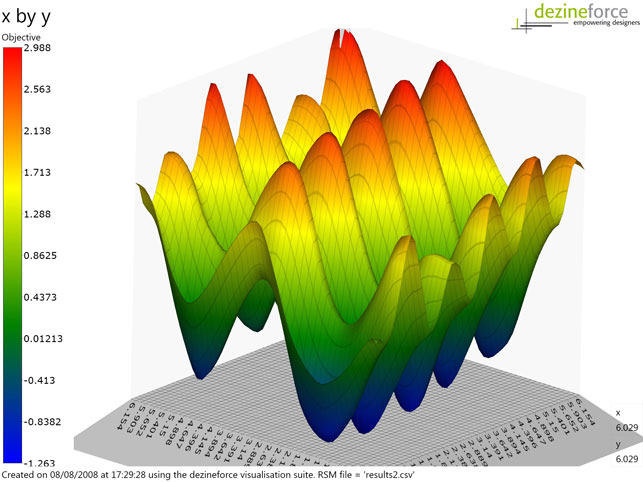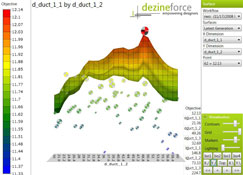Simulation, whether that’s Finite Element Analysis (FEA) or Computational Fluid Dynamics (CFD), is very processor intensive. The advent of eight-core workstations has put more power on the desktop, but simulation-led organisations with complex problems need more performance and distributed cluster-based solutions with 100s of CPUs are common. The problem is, even in today’s world of low-cost hardware, clusters can be expensive, not only in terms of capital purchase, but on-going maintenance. This is where remote computation or as the IT industry likes to call it, Cloud-based computing fits in, and leading this charge is an organisation called dezineforce.com.
Dezineforce offers a service that enables customers to run their design processes on remote high-performance computing clusters. While this is nothing particularly new, there are also some incredible value adds, specifically in terms of optimisation which lead to reduced design cycle times.

A response surface created using real data from a multi-parameter optimisation study
Genetic algorithms are used to carry out a wide-range of optimisation studies in a fraction of the time traditionally taken to explore vast numbers of combinations/iterations. This is done through ‘evolutionary optimisations’ which start with a random population, create ‘mutations’ based on user-defined success metrics and ‘breed’ them until the strongest candidate is found. Alongside this, there are other, more commonly known optimisation methods built into the dezineforce platform (such as Gradient, Hill-climb and Design of Experiments techniques) and a broad, ever expanding range of pre-set workflows for the most commonly performed simulation tasks.
The system is accessed through a web-based interface, in which the user defines the workflow, variables and the mesh to support the simulation. Controls for any optimisation are then defined, alongside convergence requirements and the actions for results handling.
As the job moves forward, its progress can be monitored, and the user can cancel it if problems are found (the usual log-file is available from the various solvers). Email notifications can also be sent as jobs are completed or limits are reached.
Dezineforce is sold on the basis of an annual or project-based subscription, tailored to need, and that subscription can take several levels – but the key concept is the number of computation hours available each month. The stopwatch starts only when the process itself is running. The setting up process is not charged for.
In terms of how many hours you will typically need, the answer is as long as the proverbial piece of string. It depends on the type of analysis you are doing (CFD is more compute heavy), the size of the design team, the nature of the problem (linear or non-linear), and how complex the optimisation parameters and variables are.

Example of dezineforce results visualisation tool, used to aid understanding of results of optimisation studies
The interesting thing about dezineforce is that in addition to being able to throw an incredible amount of compute power at a problem, the optimisation techniques used (particularly the evolutionary methods) can greatly reduce design cycle times. This is done by cutting the number of solves needed to explore a complete design space, and using informed and intelligent decisions to decide which avenues to pursue.
The beauty of dezineforce is that it encourages the use of simulation as a key driver for design exploration. By speeding up the simulation process better design decisions can be made, faster, based on more complete exploration of the design space and that can only benefit the end product. Dezineforce is not a cheap service, but for those serious about optimising their development processes, it’s certainly worth closer evaluation
simulation software support
Dezineforce works with virtually all the leading lights of the simulation world.
In terms of pre/post processor, the list includes Gambit/TGrid, ICEM and Ansys Mesh from the Ansys/Fluent stable, Patran from MSC, Primer from Oasys and Catia.
For Computational Fluid Dynamics (CFD) it works with Fluent and CFX, and for FEA, Ansys Mechanical and Rigid Dynamics, AutoDyn, MSC.Nastran, MARC, Adams and LS-Dyna.
| Product | dezineforce |
|---|---|
| Company name | dezineforce |
| Price | on application |






